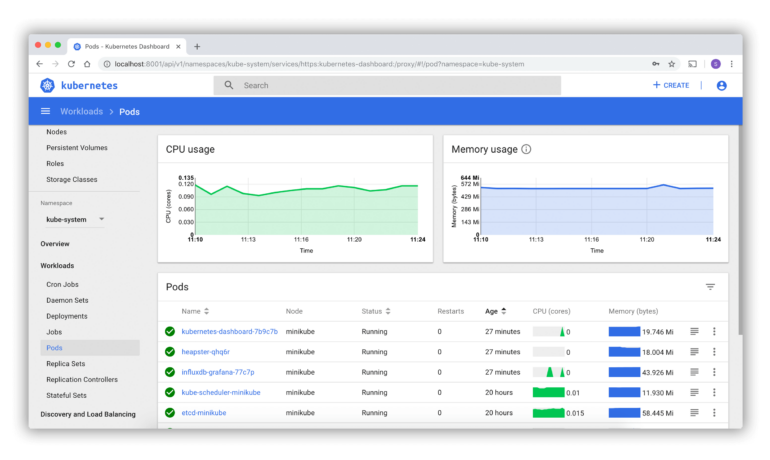Container management tools offer developers isolated, portable, and consistent environments that can help them quickly develop, test, and deploy applications across a wide variety of platforms. This guide will break down the following top container management tools in terms of features, pros, cons, and pricing so you can pick the one that best fits your software development team’s needs:
- Portainer, a great choice for beginners seeking a user-friendly container management platform with an intuitive interface.
- Kubernetes, ideal for developers seeking an orchestration and DevOps tool to automate containerized applications’ deployment, management, and scaling.
- Docker, a solid pick for developers and DevOps teams of all sizes needing a containerization tool with solid scalability, portability, and isolation.
Portainer is a container management platform that simplifies the deployment and management of Docker and Kubernetes containers. It is ideal for developers new to containerization and needing a user-friendly tool with an intuitive interface for managing container-based applications. Features of Portainer Portainer’s list of features is highlighted by: Portainer’s container status indicator lets developers see which services and containers are running/stopped and healthy/unhealthy, while its notification log lets you see a full history of all received notifications so you do not miss an important update. The developer tool has automatic stack updates for triggering a redeploy of your container, service, or stack via a webhook. It also lets you conveniently store Git credentials for multiple deployments. Portainer also has role-based access control for multiple environments, including Docker, Swarm, or Kubernetes. And it lets you manage all your image registries (Docker, Azure, GitLab, GitHub, etc.) from a single interface. Pros of Portainer Portainer’s advantages include: Portainer’s solid documentation offers users plenty of resources for getting acquainted with the container management tool. Navigating between clusters is easy, and the user interface is intuitive for users of all levels. Portainer is also user-friendly, even for beginners who are not too familiar with the world of containers. Cons of Portainer Portainer’s disadvantages include: Some users have reported that Portainer is a bit slow at times. Smaller development teams may have difficulty affording Portainer’s Business pricing options, and its error messages could use more context. Pricing of Portainer Portainer’s pricing is split between its Community and Business Edition offerings. Portainer Community Edition is an open-source developer tool for individuals or small software development teams. It is free for those looking to learn how to manage containers or needing a tool for home lab use. Portainer Business Edition is offered via the following paid plans: The Home and Student plan is restricted to non-commercial use. It includes 15 nodes and community support. The Starter plan includes five nodes, community support, and is suitable for commercial use. Professional offers scalability by adding nodes, 9×5 support, onboarding assistance, and a customer success agent. Enterprise offers scalability and onboarding assistance, too, plus an assigned success engineer, priority support, and custom MSSA. Portainer

Kubernetes (also known as K8s) is an open-source orchestration and DevOps tool that helps developers automate containerized applications’ deployment, management, and scaling. It is ideal for organizations looking to efficiently manage distributed and complex applications at scale. Features of Kubernetes Some of Kubernetes top features include: Kubernetes automatically rolls out changes to your application/configuration while monitoring health to ensure all instances are not simultaneously killed. If a mistake occurs, Kubernetes rolls back the change for you. Whether from a public cloud provider, local storage, network storage, etc., Kubernetes automatically mounts your desired storage system. The container management tool eliminates the need to modify applications using an unknown service discovery mechanism by giving Pods their own IPs and each Pod set a single DNS name while balancing loads across them. And should any containers fail, nodes die, etc., Kubernetes self-heals. Automatic bin packing is another Kubernetes highlight that saves resources and maintains availability, and it can manage batch and CI workloads, plus replace failed containers if needed. There is no need to rebuild your image or expose secrets in your stack configuration thanks to Kubernetes’ secret and configuration management capabilities, and you can scale applications up and down automatically, via a UI, or with simple commands. Pros of Kubernetes Kubernetes’ pros include: Kubernetes makes it easier for developers to update and maintain large, complex applications by automating several tasks involved in the deployment and management of containers. The programmer tool is ideal for multi-cloud deployments since it deploys on multiple cloud platforms and is flexible since it works with various containerization technologies beyond Docker. Another plus of the DevOps tool is that it can run thousands of containers while maintaining high availability. Cons of Kubernetes Kubernetes’ cons include: Teams looking to run Kubernetes for large-scale projects will require added personnel and resources for proper maintenance and management. Kubernetes may seem excessive for simple applications/services and small workloads, and those new to distributed systems and containerization will face a steep learning curve and may need extra time to get used to the DevOps tool. Pricing of Kubernetes Kubernetes is an open-source developer tool that you can download and install for free without worrying about licensing costs. While Kubernetes itself is free, you can incur costs when using the tool for infrastructure (servers or cloud providers), operations (updates, monitoring, troubleshooting, etc.), third-party tools, and more. Kubernetes

Docker
Docker is a popular open-source containerization platform and DevOps tool. It helps developers automate the deployment, management, and scaling of applications within containers and is known for its scalability, portability, and isolation.
Features of Docker

Some of Docker’s most noteworthy features include:
- Containerization
- Consistent environment
- Scalability
- Portability
- Isolation
- Security
- Docker Compose
- Docker Swarm
- Docker Hub
Docker containers are standalone, lightweight, and executable software packages that provide developers with everything they need to run applications, including code, system tools/libraries, runtime, settings, etc. Developers can improve application quality and minimize errors by using Docker’s consistent development and testing environment, plus they can scale up and down with ease for applications dealing with fluctuating workloads.
Docker containers are easier to manage and are more lightweight than virtual machines. Their portability makes application deployment across varying environments a cinch. And since they are isolated, Docker’s containers provide a barrier between applications and the operating system.
Developers can increase container security via features like network isolation and image signing. The programmer tool also features Docker Compose for simplifying complex application deployment, Docker Swarm for offering high availability and scaling applications, and Docker Hub for storing and sharing Docker images.
Pros of Docker
Docker’s strengths include:
- Docker Desktop
- Consistent environment
- Enhances scalability and security
- Simplified application packaging and deployment
The Docker desktop provides a seamless experience for creating and running containers by bundling the Docker engine and runtime utilities. The DevOps tool gives developers a consistent environment for application development and testing regardless of underlying infrastructure, and its containerization technology makes it easier to enhance scalability and security. Another Docker pro is how it provides a standardized method for building, managing, and running containers, which simplifies application packaging and deployment.
Cons of Docker
Docker’s weaknesses include:
- Complex setup and management
- Resource usage
- Native orchestration
- Application monitoring
Setting up and managing Docker for complex, large deployments can be a chore. If containers are not set up and managed properly, this could cause issues with instability and resource contention. Running Docker requires additional resources, which can negatively impact system performance. Other knocks on the programmer tool include the lack of native orchestration and out-of-the-box application monitoring.
Pricing of Docker
Docker’s four pricing plans are as follows:
- Personal: Free.
- Pro: $5 per month.
- Team: $9 per user, per month.
- Business: $24 per user, per month.
Docker’s Personal plan is geared toward individual developers and open-source communities.
It offers Docker Desktop, unlimited public repositories, Docker Engine and Kubernetes, 200 image pulls per six hours, and unlimited scoped tokens. The Pro plan is ideal for individual developers looking to boost productivity. It comes with unlimited private repositories, 5,000 daily image pulls, five concurrent builds, and 300 Hub vulnerability scans.
The Team plan is for smaller teams seeking collaboration and productivity tools. It serves up to 100 users and offers unlimited teams, bulk user additions, 15 concurrent builds, unlimited vulnerability scans, and audit logs. Lastly, the Business plan is built to provide businesses with advanced security and centralized management capabilities. It includes unlimited users, single sign-on, VDI support, SCIM user provisioning, centralized management, Hardened Docker Desktop, and registry access management.
What to Look For in Container Management Software
The ideal container management software is user-friendly, has an intuitive interface, and is known for having a strong community with solid support. While some containerization tools may be open-source and free to use, others may come via premium plans that you must review to ensure they fit your budget.
Scalability is essential for ensuring you can respond to changing traffic and resource usage, and security features like access controls, role-based access management, secret management, and container isolation are also important. Customization via configurations or extensions is another thing to consider, as is integration with CI/CD and other developer tools. Is the container management tool compatible with your infrastructure or cloud provider? Remember to keep that in mind.
Regarding features, a solid containerization tool should offer orchestration capabilities (rolling updates, automatic load balancing, etc.), networking solutions (DNS resolution, service discovery, etc.), storage management, and monitoring/logging.
Final Thoughts on the Top Container Management Tools
The containerization tools listed above are some of the best available. Before choosing one for your software development team, make sure that it fits your budget and offers the specific features you are looking for, plus its pros outweigh its cons.







